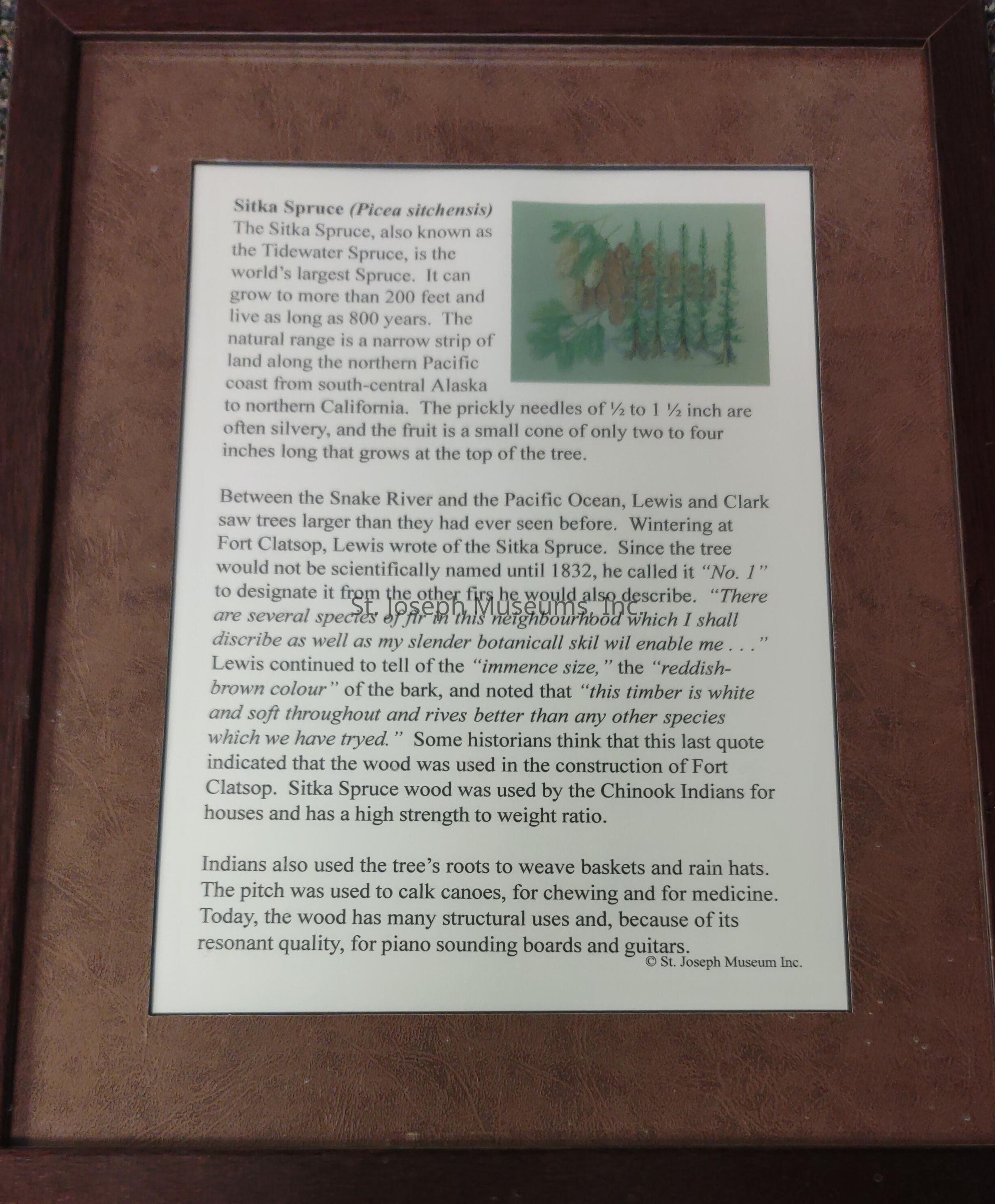Name/Title
Sitka Spruce (Picea sitchensis)Entry/Object ID
2021.1.46 BScope and Content
Sitka Spruce (Picea sitchensis) plant description, framed.
The Sitka Spruce, also known as the Tidewater Spruce, is the world's largest Spruce. It can grow to more than 200 feet and live as long as 800 years. The natural range is a narrow strip of land along the northern Pacific coast from south-central Alaska to northern California. The prickly needles of 1/2 to 1 1/2 inches are often silvery, and the fruit is a small cone of only two to four inches long that grows at the top of the tree.
Between the Snake River and the Pacific Ocean, Lewis and Clark saw trees larger than they had ever seen before. Wintering at Fort Clatsop, Lewis wrote of the Sitka Spruce. Since the tree would not be scientifically named until 1832, he called it "No. 1" to designate it from the other firs he would also describe. "There are several species of fir in this neighbourhood which I shall discribe as well as my slender botanicall skil wil enable me..." Lewis continued to tell of the "immence size," the "reddish-brown colour" of the bark, and noted that "this timber is white and soft throughout and rives better than any other species which we have tryed." Some historians think that this last quote indicated that the wood was used in the construction of Fort Clatsop. Sitka Spruce wood was used by the Chinook Indians for houses and has a high strength to weight ratio.
Indians also used the tree's roots to weave baskets and rain hats. The pitch was used to calk canoes, for chewing and for medicine. Today, the wood has many structural uses and because of its resonant quality, for piano sounding boards and guitars.Context
Originally designed by the St. Joseph Museum in the fall of 2004. Titled "Botanical Wonders of the Uncharted West. The Recorded Flora of the Lewis & Clark Expedition."Collection
Lewis and ClarkLexicon
LOC Thesaurus for Graphic Materials
Botanical drawings, Expeditions & surveysArchive Items Details
Title
Sitka Spruce (Picea sitchensis)Creator
Mary L. FletcherDate(s) of Creation
2004Subjects
Plants, Watercolor paintingsParts
Count
2Parts
Watercolor of plant and descriptive label, both framed.Condition
Overall Condition
Very GoodProvenance
Notes
"Botanical Wonders of the Uncharted West" visually depicts how well Lewis followed Jefferson's instructions. In recognition of this achievement, The S. Joseph Museums, Inc. commissioned accomplished artist Mary Fletcher to create fifty (50) selected paintings of flora documented by the Corps during their Journey. These framed watercolor originals are accompanied by similarly framed labels, generated by former Head of Research Jackie Lewin, which describe the corresponding plants with appropriate quotations from the Journals. This collection makes available for study and appreciation plants that were new to Lewis and Clark, but which Native Peoples already recognized as valuable sources of food, medicine, and tools. Some of these still remain a mystery to many, but all will enjoy their beauty, their diverse uses, and their accomplished renderings.
